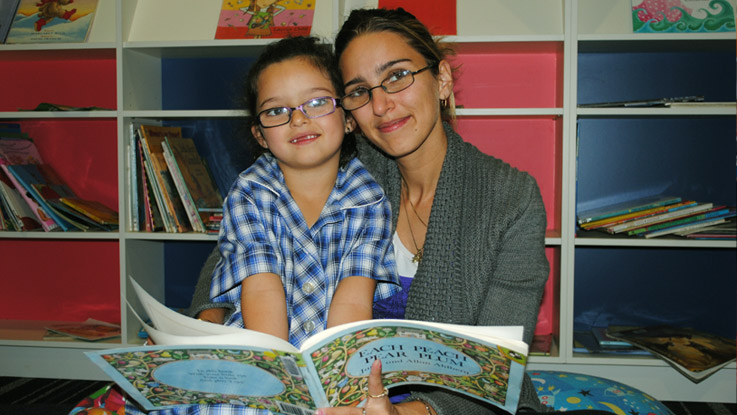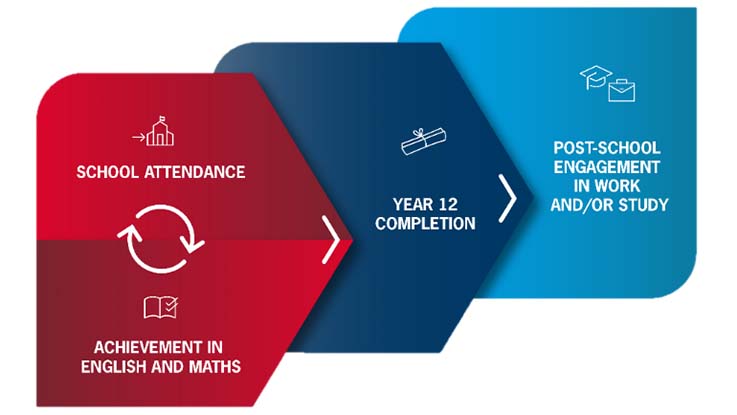
Smith Family report finds new evidence to help children at risk of leaving school early
Groundbreaking research by children’s education charity The Smith Family has shown school attendance rates in Year 7 can predict students at risk of not completing Year 12.
Three in four students (75 per cent) with high attendance in Year 7 completed Year 12 compared to less than half (48 per cent) of those with very low attendance, according to the study of more than 30,000 Australian school students.
The research also shows that students with very low attendance rates in Year 7 who improved their attendance by Year 9 were much more likely to complete Year 12.
The Smith Family report – Attendance lifts achievement: Building the evidence base to improve student outcomes – is the first Australian study to demonstrate the relationships between students’ school attendance, achievement in English or Maths, school completion and post-school work or study.
Anne Hampshire, The Smith Family’s Head of Research and Advocacy, said at a time of significant public interest in how we can improve educational outcomes in Australia, the report provides evidence of the importance of monitoring attendance and achievement throughout a child’s schooling years to help identify students who need additional support.
“Thousands of young Australians are not achieving educationally. Young people from disadvantaged backgrounds are particularly at risk of poor educational outcomes. We want to be able to identify as early as possible those young people who need extra support,” Ms Hampshire said.
“Our research has found attendance and achievement even in a child’s early years of high school can help identify students at risk of not completing Year 12. Importantly, we’ve also been able to show that if we can support students to improve their attendance and grades as they move through school, they are much more likely to finish school and go on to further study or work.”
Ms Hampshire said while these findings make intuitive sense, this is the first time the relationships between outcomes across a young person’s educational journey have been confirmed. It involved analysis of seven years of longitudinal data from more than 30,000 disadvantaged students participating in The Smith Family’s Learning for Life program.
“Intuition is not enough on which to base our educational investment. We need evidence to build a more sophisticated understanding of the early flags for poor educational outcomes.
“The Smith Family is able to release these findings because we’ve been tracking the progress of over 30,000 students on our Learning for Life program over several years. Each student has a unique student identifier (USI), which enables us to monitor individual outcomes over the long term.
“By using this data, we can improve the effectiveness of our own programs but the impact of this research is far broader. We’re hoping schools, parents, education departments and those who invest in educational initiatives will use this evidence – because if we use evidence we can help improve the educational outcomes of all young Australians, particularly those from disadvantaged backgrounds.
“This analysis reinforces the value of a national USI for all Australian students to support their individual needs and to evaluate the impact of educational initiatives. A USI is particularly important for disadvantaged students who tend to move schools more often,” Ms Hampshire said.
Research in action: Early School Leavers initiative
This research is underpinning a new pilot program supporting students in Years 9 to 11 who are at risk of leaving school early. The Smith Family’s Early School Leavers initiative is being trialled with students on the Learning for Life program in 10 communities across NSW and Victoria in 2018, with the support of the Citi Foundation.
The pilot uses educational data (such as attendance and achievement) to identify young people at risk of early school leaving and provides more intensive support to help them stay at school. This includes career coaching to help them set goals for the future, skills development opportunities including with employers, vocational cadetships and referrals to community supports and services.
“Being able to identify which students are at risk of leaving school early and providing them with additional support to complete Year 12 will help them achieve better long-term life outcomes and positively impact on the Australian community,” Ms Hampshire said.
“Conservatively, the economic cost to the nation is close to $1 million1 for every young person who doesn’t complete school. In addition, there’s a huge cost to the young person themselves – they’re more likely to have poorer health outcomes, be reliant on income support and socially disconnected from their community. So there’s a real burden, both to the young person but also to the nation as a whole.
“We want to share this research with the Australian community because there’s such a need to build the evidence base to improve the educational outcomes of young Australians. And there’s a strong message of hope in this research: it shows that with the right support at the right time, a young person’s attendance and achievement can improve – and if we get those improvements happening, they are likely to complete school and move into further study or work.
“The evidence is telling us that change is possible and we can get a lot more young people, including those from disadvantaged backgrounds, finishing Year 12 and on the pathway to a better future.”
The full report is available for download at thesmithfamily.com.au/attendance-lifts-achievement
KEY FINDINGS
Attendance matters:

- 75 per cent of students with high rates of attendance in Year 7 completed Year 12, compared to only 48 per cent of those with very low rates of attendance.2
- 61 per cent of students who had low attendance in Year 7 and improved their attendance by Year 9 completed Year 12, compared to only 35 per cent whose attendance remained very low.
- 82 per cent of high attenders in 2013 were engaged in work and/or study post-school in 2017, compared to only 66 per cent of low attenders.
Achievement matters:
- 88 per cent of Year 9 students who achieved an A (excellent) in English subsequently completed Year 12, compared to only half (50 per cent) of those who achieved an E (minimal).
Year 12 completion matters:
- 82 per cent of students who completed Year 12 were engaged in post-school work and/or study, compared to only 68 per cent of those who only completed Year 10.
About the Learning for Life program
The Smith Family’s Learning for Life program provides long-term, targeted support to help disadvantaged children and young people succeed educationally. The program helps build knowledge, skills, motivation, self-belief and a network of positive relationships with parents, peers, employers and the wider community. This support is proven to increase a young person’s likelihood of remaining engaged with school, completing Year 12 and developing informed study and career pathways for life beyond the school gate.
Media contacts:
Andrew Dickson | National Media Manager (National) - 0421 285 529 | andrew.dickson@thesmithfamily.com.au
Carla Horton | Senior Media Advisor (QLD & WA) - 0423 618 776 | carla.horton@thesmithfamily.com.au
Reid Jermyn | Media Advisor (VIC, SA & NT) - 0412 803 566 | reid.jermyn@thesmithfamily.com.au
Ben Chenoweth | Senior Media Advisor (NSW, ACT & TAS) - 0413 346 934 | ben.chenoweth@thesmithfamily.com.au
The Smith Family is a national children’s education charity that helps young Australians experiencing disadvantage to create better futures for themselves through harnessing the power of education. We partner with around 800 Australian schools and work with over 186,000 children and young people experiencing disadvantage access our education support programs to help them overcome. For more information, visit thesmithfamily.com.au
